When an employee decides to leave an organization, there are multiple things that get set into motion. HRs have to complete several processes that require departing employees’ participation too. It gets even trickier when everyone is working remotely. That is where having a documented employee offboarding process becomes a necessity rather than a requirement.
An employee offboarding process is not just essential for ensuring a proper handoff of documentation and information but also for ensuring that the productivity of other team members does not get impacted. And considering the new work models, remote and hybrid, conventional offboarding methods are no more efficient and valuable for organizations.
So, what can you do? Redesign your employee offboarding process.
How? Read this blog to know all the steps necessary for setting up a remote offboarding process and keep things streamlined while parting ways with the employees.

What is an employee offboarding process?
The employee offboarding process implies a formal separation between an employee and a company through retirement, termination, or resignation. It includes all the tasks and activities such as knowledge transfer, exit interviews, asset handover, etc., to transition an employee from an active company member to a former employee.
Significance of remote employee offboarding for businesses
A smooth remote employee offboarding process is vital for all: employees making exits, new hires replacing them, and HRs to avoid business disruptions. Here is why:
Makes employees feel valued
Yes, you have to let go of employees sometimes for them to progress in their careers. But it does not mean that you have to lose touch with them forever.
Instead, you should design an offboarding process that builds a sense of community among all your ex-employees and help them feel valued. Your HR team should focus on providing them with a positive and memorable experience that they reminisce about for years even after leaving the organization!
Prevents room for errors or confusion
An effective offboarding plan should be curated carefully so that there is no room for error or confusion. It should encompass the details of the steps and activities to be completed at each stage of the offboarding process.
Further, if an employee resigns amidst an ongoing project, HRs should ensure that such lapses do not impact project deliverables. They can delegate and execute a streamlined offboarding process to avoid affecting other team members’ productivity and project deadlines.
Increases probability of future collaborations
Facilitating the departure of employees is not sufficient today: bidding them goodbye on good terms is what matters these days. Since most people transition from one role to another in similar industries, there is always a possibility of crossing paths.
With a thoughtfully designed employee offboarding program, you will not only ensure that employee leaves with a positive mindset but is also open to collaborating or partnering with you when the opportunity arises.
Prevents data breaches
New employees who become a part of your company and acclimate to the organization through an onboarding process feel inclusive of your company and culture.
However, when the time comes for them to leave, you must not ignore the significance of offboarding exercise. You should conduct the offboarding process meticulously to ensure exiting employees do not have access to sensitive information or any other details that are crucial for your organization. Any kind of data leakage could prove detrimental to your business.
Saves organization from legal and financial issues
A well-executed offboarding program has many benefits for both- the employee and the employer.
Employees can transfer all of their information and documents to the employer while HRs can ask employees to sign a non-disclosure agreement (NDA) to ensure departing employees meet all their privacy regulations to avoid breaches.
Employers must create an offboarding process to ensure that their organization does not lose any information or property of the employee. It can reduce costs during onboarding new employees and even keeps you safe from legal issues that can arise from leaking sensitive data.
Provides valuable feedback
Successful enterprises have a well-thought offboarding process for employees. HRs in such enterprises ensure the process remains transparent and clear to the employees. It becomes simpler to gather their valuable and candid feedback during exit interviews.
Moreover, exit interviews help organizations understand the departing employee’s views and opinions about the organization, ideas for improvements, and the real reason for their departure.
Smart organizations not only facilitate the exit interview process but analyze and act on the results. Ultimately, the appropriate actions regarding the feedback will reduce turnover in the future and foster a positive work culture.
Seven steps to include in your remote employee offboarding checklist
An employee offboarding program may vary from organization to organization. For that matter, it may also vary based on the role an employee is resigning from. But an efficient offboarding process will always have the following steps documented and well implemented.
1. Communicate the departure quickly to the company
While most companies hold off on informing relevant team members about their colleagues’ departure, it is best to communicate this information immediately while working in a remote setup.
HR managers should first communicate this information to immediately affected staff like supervisors and senior managers to help them inform their respective teams about the change. It will ensure that every teammate across hierarchies is informed well in time and can work on filling in the gaps. The proactive communication also reduces the room for gossip and rumor-mongering around the employees’ exit.
2. Send the offboarding email and relevant documents
Based on how the employee exits – voluntarily or involuntarily, the HR team may have to tweak the documents before sending them out.
An HR should start with an email acknowledging the resignation/ involuntary termination and then send follow-up emails that share information about the next steps. Additionally, HRs may have to send a non-disclosure agreement, relieving letter, letter of recommendation, and other documents while completing the exit process.
in case your company offers severance packages or other benefits for departing employees, this would be a good time to share the details with them.
3. Focus on knowledge transfer
Knowledge transfer is a crucial step to handle during an employee’s notice period. Any client work or ongoing tasks that an employee was working on should be documented and organized well so that the employee replacing them can pick it up without missing a beat. HRs can facilitate it either through written documents or by creating videos so that the handover process goes over smoothly.
Additionally, if your employee leaves on good terms and you need some assistance later in tracking down some work, they will happily oblige and help you out.
4. Carry out an exit interview
An exit interview will allow you to gain insights into why someone left so that you can improve upon things like benefits, compensation packages, or responsibilities that come along with the job role.
To truly uncover rich insights for your organization, you may want to ask questions that provide a SWOT analysis for the role. A SWOT analysis covers strengths, weaknesses, opportunities, and threats. You can also include questions about the company’s culture to improve it in the future.
5. Recover company assets
A step some organizations overlook is recovering company assets from a departing employee. While most remember to take back physical assets, they tend to forget about revoking access to internal software and network.
On the last working day of an employee, your IT team must revoke system access and take back the company-assigned phone, laptop, keys, uniform, company car, ID, and security access. In case of any expense account, you should settle the dues and reimbursements before their departure to avoid the hassle.
6. Revoke system access and benefits
Apart from revoking network access, you will have to withdraw the departing employee’s access to company emails, social media accounts, and CRM software. If they handle crucial information, ensure that an employee is assigned to cancel their login accounts and access from sheets like sales, company finances, client agreements, etc.
In case of an involuntary exit, you may want to immediately revoke all kinds of access to company information to prevent security breaches.
7. Thank employees for their contribution
Lastly, it is paramount to depart on a positive note once the paperwork and handover are complete. To do this, you may want to express gratitude to the employee you are offboarding for their contribution to the company and for being a part of its success and wish them luck in their future endeavors.
If your company has developed a culture of bidding farewell to people in the form of a party, you may want to get all the affairs in order.
Since most employee exits are now happening remotely in a virtual setting, you can ask people of the company to be a part of a short team meeting where everyone says a few kind words to their departing teammate. You may also pass around a digital card for every employee to sign as a parting gift.
Additionally, you may send the employee a care package and add them to the company’s alumni group to stay in touch with them.
Employee offboarding best practices
Having a documented remote employee offboarding process and program in place can help you keep things streamlined and easy flowing. But in addition to the same, we recommend following these best practices for smooth employee offboarding experiences:
Understand the nature of the exit
As a manager, you may encounter various situations relating to an employee’s exit. Some of these situations include unexpected employee exit, an employee resigning due to stagnancy, or termination due to poor performance. Understanding the nature of an employee’s exit will help you determine how much effort you should put in while they are still in your employment.
- If they leave unexpectedly, you should take the time to discover why they left.
- If they have left on their own accord, you can try to get them to stay.
- If someone is leaving because of a bad experience at work, you can resolve the issue to keep them from going.
- If someone is terminated, you should find out what went wrong and use the experience to improve for the future.
Keep everyone in the loop
By having all stakeholders aware, you can ensure continuity without any hiccups. The departing employee will know the steps they will have to follow during their exit, while the person taking over the responsibilities will work towards getting briefed about their incoming responsibilities.
End on a positive note
Once a resignation is received, most employers turn bitter and resentful. However, if the parting employee is treated with dignity and grace during the exit process, they not only return in the future but also become ambassadors of your work culture to the outside world.
Review documentation and plan hand-off
Refer to the employee documentation checklist to offboard employees properly. An HR representative should collaborate with the departing employee to determine the next steps in the offboarding process, such as the last day of working, reviewing the documents, etc.
Once both the HR representative and the employee agree on exit formalities, HR can trigger the hand-off process.
You can further bring efficiency to the process by using HR automation and document management platforms powered by AI and NLP. It will help you eliminate the typical back-and-forth follow-ups.
Reset the passwords and accounts
The simplest way to safeguard your organization’s data and information is by resetting all the account passwords of the departing employees and revoking access where necessary. It should happen at the end of the day of their departure date.
However, in the case of a disgruntled employee, you may want to act by taking away all access immediately to prevent any leaks and breaches.
It holds to even common email addresses and logins you may have provided to different departments; for example, marketing@organization.com.
Acknowledge the employee’s feelings
Managing employee resignations is more complicated than onboarding new employees. That is why a manager must focus on acknowledging the employee’s feelings and treat them with respect in their last days at the company. The way an organization manages a resignation speaks volumes about the company’s culture.
Summing up
A remote employee offboarding program is quite challenging to execute as compared to the in-person offboarding process. So, you should focus on setting up a proper process and optimizing the above-stated points according to your company’s requirements.
But in general, you can follow this all-inclusive remote employee offboarding checklist:
- Prompt communication about the departure
- Initiate paperwork
- Focus on knowledge transfer during the notice period
- Conduct an exit interview
- Recover assets and access
- Express gratitude
- Keep up with the communication
- Provide an opportunity to re-enter the company
Unfortunately, manual processes always leave room for errors and miss out on tying up loose ends. That is why you should use a robust, automated offboarding program. It will empower HRs to bid goodbye to valued employees professionally. With Leena AI, you can now automate your entire offboarding experience in just a few clicks! Book a demo today!






